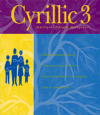Cyrillic 3 uses the BRCAPro and Mendel software programs to assist in genetic risk assessment.
About BrCaPro
 Breast cancer is the second most common cancer in women (after skin cancer). The risk of developing breast cancer in the normal population of the United States and Europe is 8%-10%. A family history of breast cancer is present in approximately 10% of overall cases. Breast cancer susceptibility genes BRCA1 and BRCA2 have recently been identified (Miki et al, 1994; Wooster et al, 1995). Both BRCA1 and BRCA2 are considered to be responsible for a similar proportion (40%) of inherited breast cancer (Bennett et al, 1999) but the majority (81%) of the breast-ovarian cancer families are due to BRCA1 whereas BRCA2 is found in the majority (76%) of families with male and female breast cancer (Ford et al, 1998). Carriers of BRCA1 or BRCA2 mutations from families with high cancer risk have been estimated to have an 85% lifetime risk of developing breast cancer (Bennett et al, 1999). In addition, BRCA1 mutations' carriers have a 65% lifetime risk of developing ovarian cancer (Easton et al, 1995).
Breast cancer is the second most common cancer in women (after skin cancer). The risk of developing breast cancer in the normal population of the United States and Europe is 8%-10%. A family history of breast cancer is present in approximately 10% of overall cases. Breast cancer susceptibility genes BRCA1 and BRCA2 have recently been identified (Miki et al, 1994; Wooster et al, 1995). Both BRCA1 and BRCA2 are considered to be responsible for a similar proportion (40%) of inherited breast cancer (Bennett et al, 1999) but the majority (81%) of the breast-ovarian cancer families are due to BRCA1 whereas BRCA2 is found in the majority (76%) of families with male and female breast cancer (Ford et al, 1998). Carriers of BRCA1 or BRCA2 mutations from families with high cancer risk have been estimated to have an 85% lifetime risk of developing breast cancer (Bennett et al, 1999). In addition, BRCA1 mutations' carriers have a 65% lifetime risk of developing ovarian cancer (Easton et al, 1995).
Family members at higher risk of breast cancer can now be tested to see whether they are BRCA1 or BRCA2 carriers. An individual who undergoes genetic counseling before testing can be told the probabilities that he or she is a carrier, given the family history.
BRCAPRO is a program, developed by G. Parmigiani, D.A. Berry and O. Aguilar at the Institute of Statistics and Decision Sciences, Duke University, U.S.A., which calculates the probability that a particular family member carries a germ-line mutation of the BRCA1 and BRCA2 genes. Although the method applies to both women and men, the proband is usually female. The calculations are based on Bayes' rules of determination of the probability of a mutation, given family history. An estimate of the mutation frequencies in the normal population (Claus et al, 1996; Ford et al, 1998) and among Askenazi Jews (Struewing et al, 1997) provides the probability of the mutation in the proband, prior to the ascertainment of family history. The family history includes the proband and first- and second- degree relatives. No provision is made for inbreeding, monozygous twinning, or for other relatives. While for many families BRCAPRO will give a useful estimate of risk, there are some families where important information will not be used in the calculation. For each member of interest, it is important to ascertain whether he or she has been diagnosed with breast cancer and either the age at diagnosis or, if cancer free, the current age or the age at death.Unaffected members are important in the calculation, but only if their current age or age at death is known. The method assumes that individuals inherit two BRCA1/BRCA2 alleles, one from each parent, that alleles are either normal or mutated and that mutations are inherited independently through an autosomal dominant mode of inheritance. For detailed explanation of the method the user is referred to the authors' publication (Parmigiani et al, 1998)
Bennett et al. The genetic basis of breast cancer and its clinical implications. Aust NZ J Surg 1999;69:95-105.
Claus et al. The genetic attributable risk of breast and ovarian cancer. Cancer 1996;77:2318-2324.
Easton et al. Breast and ovarian cancer incidence in BRCA1-mutation carriers. Am J Hum Genet 1995;56:265-71.
Ford et al. Genetic heterogeneity and penetrance analysis of the BRCA1 and BRCA2 genes in breast cancer families Am J Hum Genet 1998;62:676-689.
Miki et al. A strong candidate for the breast and ovarian-cancer susceptibility gene BRCA1. Science 1994;266:66-71.
Parmigiani G, Berry DA, Aguilar O. Determining carrier probabilities for breast cancer-susceptibility genes BRCA1 and BRCA2. Am J Hum Genet 1998;62:145-158.
Struewing et al. The risk of cancer associated with specific mutations of BRCA1 and BRCA2 among Askenazi Jews. New Engl J Med 1997;336:1401-1408.
Wooster et al. Identification of the breast-cancer susceptibility gene BRCA2. Nature 1995;378:789-791.
About Mendel
MENDEL is a set of Fortran 77 routines for the genetic analysis of human pedigree data. Its use is well established for segregation analysis, linkage calculations and genetic counseling. A detailed description of the algorithms is provided in Lange et al, 1988. Users can also consult other papers by Lange and colleagues (Lange and Elston 1975; Lange and Boehnke, 1983; Lange and Goradia, 1987; Goradia et al, 1992) for the theoretical background.
Cyrillic incorporates a version of MENDEL which performs likelihood calculations for conditions with age-dependent penetrance. MENDEL automatically handles both inbreeding and monozygous twinning.
As standard, Cyrillic is provided with penetrance tables for predisposition to breast/ovarian cancer based on Claus population frequencies (Claus et al, 1996). It is however possible to input one's own population data (penetrances, prior probabilities of genotypes), and to use MENDEL for other disorders. An option to use the Gompertz function for penetrances as an alternative to penetrance tables.
Claus et al. The genetic attributable risk of breast and ovarian cancer. Cancer 1996;77:2318-2324.
Goradia et al. Fast computation of genetic likelihoods on human pedigree data. Hum Hered 1992;42:42-62.
Lange et al. Programs for pedigree analysis: MENDEL, FISHER, and dGENE. Genet Epid 1988;5:471-472.
Lange K, Elston RC. Extension to pedigree analysis. I. Likelihood calculations for simple and complex pedigrees. Hum Hered 1975;25:95-105.
Lange K, Boehnke M. Extensions to pedigree analysis. V. Optimal calculation of Mendelian likelihoods. Hum Hered 1983;33:291-303.
Lange K, Goradia TM. An algorithm for automatic genotype elimination. Am J Hum Genet 1987;40:250-256.



 Economic and Financial Assessments
Economic and Financial Assessments 
